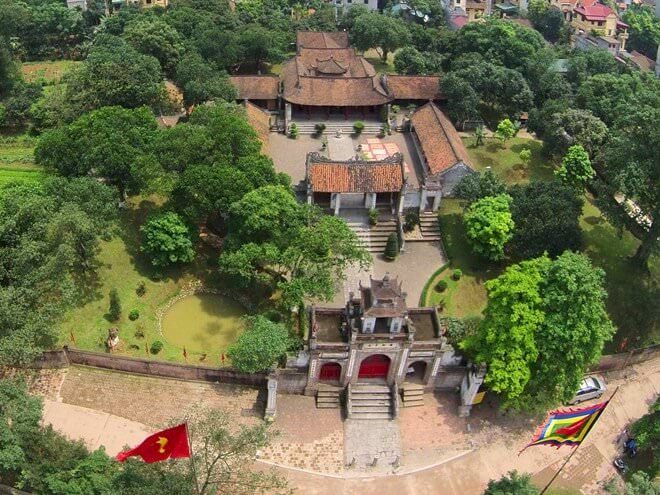Co Loa Citadel - The oldest citadel in Vietnam
Co Loa citadel is a tourist destination imbued with historical and artistic values. Let's spend a beautiful weekend exploring Co Loa citadel.
'
1. Where is Co Loa Citadel?
Located 24km away from the city center, the historic site of Co Loa citadel is spread over the territory of 3 communes: Co Loa, Viet Hung, Duc Tu in Dong Anh district, Hanoi. With an area of up to 500 hectares, this is the oldest citadel in Vietnam. Co Loa citadel which is built in the 3rd century BC under King An Duong Vuong was the capital of the Au Lac state and the feudal state under Ngo Quyen in the 10th century.
'
2. How to get to Co Loa Citadel?
Going by Bus:
There are many bus routes to Co Loa. You can refer to a few lines below:
Route 15: Gia Lam bus station – Pho Noi
Route 17: Long Bien – Noi Bai
Route 46: My Dinh bus station – Dong Anh town
Route 59: Dong Anh town – Vietnam Academy of Agriculture
Ticket prices range from 7,000 VND - 9,000 VND/time
Going by Personal vehicles
If traveling by private vehicle as cars, motorbikes, you can follow the suggestions below:
Starting from Thang Long bridge: you move along Pham Van Dong - Thang Long bridge - turn down Hai Boi - 6 km road - out to Highway 3 - Co Loa street.
Starting from Chuong Duong bridge: from the city center move to Chuong Duong bridge - Nguyen Van Cu - Dong Tru bridge - Tien Hoi street - Highway 3 - Co Loa street.
Starting from Nhat Tan bridge: from the city center move to Nhat Tan bridge - turn down the extended 5th street - to the junction, turn to Highway 3 - Co Loa street.
'
3. The Architecture of Co Loa Citadel
The citadel was built with a spiral design, so it also has another name Loa citadel.
According to legend, Co Loa citadel consists of 9 spirals rings, but based on the remains, scientists find that the citadel has 3 rings, of which the inner citadel is most likely built later, in the Ngo Quyen Dynasty. The circumference of the outer ring is 8 km, the middle's is 6.5 km, the inner's is 1.6 km, the central area is up to 2 km². The outside of the rampart is sloping, it's hard to be hit from outside but easy to hit out. The average height of the rampart is 4–5 m, even 8–12 m high in some places. The base of the rampart is 20–30 m wide, the surface of the rampart is 6–12 m wide. The volume of excavated earth is estimated at 2.2 million cubic meters.
- The inner ring is rectangular, with an average height of rampart is 5 m above the ground, the surface of the rampart is from 6-12 m wide, the base is from 20-30 m wide, the circumference is 1,650 m. There is a door leading to the Ngu Trieu Di Quy architectural building
- The middle ring is around with asymmetrical shape, has 6,500 m long, 10 m high at the highest point, 10 m wide on average, with four gates in the 4 directions: east, north, northwest, southwest. The east gate connects with the Red River.
- The outer ring also has no clear shape, more than 8,000m long, 3–4 m high (in some places more than 8 m).
- Each citadel has a moat surrounding the outside, the average width is from 10m to 30m, even wider in some places. The moats are connected to each other and to the Hoang River. The combination of rivers, moats and walls had no definite shape, making the castle like a labyrinth, a military area that was good for both attack and defense.
The Hoang River is used as a natural moat for the outer citadel in the southwest and south. The remaining moat was dug close to the base of the rampart from Cot Co mound to Ca pond. This moat connects with the moats of the middle citadel at Ca pond and Mit humlet. The water flows through Cong Song estuary, connects with five creeks shaped like hands, then flows into the inner citadel's moat through one of these creeks.

'
4. Historical significance of the citadel
In Au Lac's reign, Co Loa was located in an extremely favorable position, on the top of triangle of the Red River delta where is an important focal point of both road and waterway, being a place witnessing the development stage of the ancient Vietnamese inhabitants. Therefore, this place was chosen as the capital of Au Lac nation from the 3rd century BC and the state of King Ngo Quyen in the 10th century AD.
This is the place to gather a series of archaeological sites reflecting the continuous development of the Vietnamese nation through the periods from its beginning. Thanks to that, archaeologists have discovered the unique and valuable Dong Son culture, also known as the Red River civilization in the prehistoric period of the Vietnamese nation.
Considered as "the large-scale oldest citadel with the structure is also the most unique in the history of citadel construction of the ancient Vietnamese", Co Loa is now recognized as one of the 21 National tourist areas. Coming here, you will visit the complex of famous works such as An Duong Vuong temple, Co Loa communal house, Ngoc well, Cao Lo statue, My Chau temple... which are all located in the ancient citadel relic area.

'
5. Attractions in Co Loa citadel
Entrance Tickets: 10,000 VND/person.
Opening time: 6:30 am to 6:00 pm every day.
/
Temple of An Duong Vuong
Traveling to Co Loa citadel must first attend the temple of An Duong Vuong, also known as Thuong Temple - where the king lived before. The architecture of the temple area is also very unique expressed through the carvings and mascots in front of the temple gate.

'
Ngoc Well
Ngoc Well is located in the middle of Crescent Lake in front of King An Duong Vuong's temple. If viewing from afar, the water in Ngoc well will like having slightly bloodshot color, striking between the clear blue of the water in the lake and the green of trees.
According to an old legend, this is the place where Trong Thuy threw himself down because he regretted and mourned for My Chau.

'
Ngu Trieu Di Quy - Co Loa communal house
Ngu Trieu Di Quy is the place where the king used to set up his court. This place was built superficially with many typical architectural features such as Tu Linh and Tu Quy. Under the Le Dynasty, this communal house was firmly rebuilt and kept its value almost intact until today.

'
My Chau Temple
According to legend, this is the resting place of Prince My Chau. Because when she threw herself into the sea to commit suicide, the fisherman nearby saw a headless human-shaped rock washed up on the shore, shouted for the person to carry it back. While people were carrying the statue, the hammock broke right at the place of current My Chau temple, lying to the left of the Di Quy shrine, under a big banyan tree.
Although it is not known whether the legend is true or not, today the temple still worships Princess My Chau statue without a head in nice and smart decoration.

'
Cao Lo Temple
Cao Lo was a talented general under King An Duong Vuong, known as the father of weapons of Vietnam. He is the author of the magic crossbow - Lien Chau crossbow and he is also the direct commander of the construction of Co Loa citadel. The temple was built to commemorate the great merits of this general.

'
Festival in Co Loa citadel
The festival of Co Loa citadel will last from January 6 to January 16 every year. Just like the death anniversary of Hung Vuong, this is an opportunity for people to remember the merits of building the citadel of Thuc Vuong. Besides, people also come here to pray for favorable weather, good seasons and a peaceful new year.

'
6. Co Loa citadel's specialties
Co Loa is famous for its rich and nutritious mussel porridge. Porridge is served with bagel twists, fried onion, salted shredded pork and a few pieces of pickled egg plants.

Besides, Soc Son cuisine is also very unique with dishes with bold flavors of the Northwest mountains such as bird spring rolls, snail rolls, hill chicken, plain rice flan with green sauce...
Loa Citadel Lotus restaurant: 34 National Highway 3, Co Loa, Dong Anh, Dong Anh, Hanoi
Son Vien Restaurant: 57 National Highway 3, Dong Anh, Hanoi
Loa Citadel cuisine restaurant: Vang hamlet Ball Court, Co Loa, Dong Anh, Hanoi.
'
Source: collected










